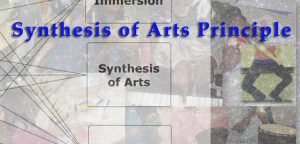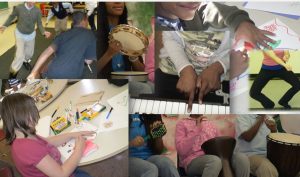This page explains in general terms the second IAM principle – synthesis of arts.
Overview of Synthesis of Arts Principle
The synthesis of arts principle reinforces the human ability to associate, see beyond a single discipline, and develop perspectives that are well integrated and creatively expressive. Synthesis of arts in IAM pedagogy involves teaching various arts in close proximity or simultaneously, with the aim of developing shared meaning or associative memories of those arts in students. This allows integration by associating broad schemas of learning. The synthesis of arts principle can accelerate learning of the involved arts (or subject areas). Because learning is multi-sensory, experiencing new knowledge through various modes and senses will strengthen and enhance the encoding (Goswami 2008), and provide more meaning-related associations (or inter-connections) during the shared experience. Thus, if the areas of art are experienced or encoded in a joined educational setting, they become a connected knowledge network (or schema, Sweller et al. 1998). If the initial encoding did create a united experience that involved multiple arts, then the subsequent recall of one of the arts will involuntarily activate the memories or subconscious experience of the other connected arts (Goswami 2008), such as remembering a dance by hearing its music, thus improving mental and subconscious recall (more on this in Soyfer 2016, Chapter 2, sections Theory and Science of Education pp. 44-60, and Social Emotional Learning and Mindfulness pp. 75-80).
 The synthesis of arts principle is facilitated through four specific synthesis types as follows:
The synthesis of arts principle is facilitated through four specific synthesis types as follows:
1) structural synthesis (where all arts are practiced in one class),
2) creative synthesis (where the experience of one art inspires creativity within another through associative connections within each student’s mind and body),
3) developmental synthesis (where practicing one skill related to an art improves the physical and technical capacity for another skill within another art), and
4) synergistic or group synthesis (where the members produce synthesis ofarts experiences as a group, such as dancing by some students and music by others, and exchanging these roles, which gradually broadens all members’ relevant knowledge schemas to include all related arts as an integrated experience).
These types of synthesis express the four ways in which IAM enhances experience and accelerates learning of appropriately associated arts. Together, they aim to develop shared, broad, and multi-faceted modes of artistic expression in every student.
Chapter 2 (IAM Related Research and Literature) of Integrated Arts Pedagogy and Philosophy (Soyfer 2016, pp. 43-136) provides evidence supporting the benefits of facilitating the synthesis of arts principle (for example see Soyfer 2016, section Multi-Sensory Learning pp. 59-61; and section Mindfulness and Education pp. 77-78), while chapter 4 (Soyfer 2016, pp. 249-298) demonstrates its practical application through the sample of one real-world Integrated Arts Program (Soyfer 2016, section IAM Programs in Practice pp. 255-294).
The facilitation of these three aspects is exemplified in Dr. Soyfer’s dissertation through IAM’s pedagogical approach to teaching the sample music repertoire, i.e., in chapter 3 (IAM Music Pedagogy and Repertoire, Soyfer 2016, 135-248) and appendix B (IAM Sample Music Repertoire, Soyfer 2016, 354-563); and all three subject areas: music, dance, and visual arts, i.e., in chapter 4 (IAM Planning and Facilitation, Soyfer 2016, 250-298) and appendix A ( IAM Activities and Techniques, Soyfer 2016, 314-353).
Bibliography:
Goswami, Usha. 2008. “Principles of Learning, Implications for Teaching: A Cognitive Neuroscience Perspective.” In Journal of Philosophy of Education, vol. 42, nos. 3-4, pp. 381–399. http://onlinelibrary.wiley.com/doi/10.1111/j.1467-9752.2008.00639.x/pdf (accessed February 1, 2015).
Soyfer, Nina. 2016. “Integrated Arts Pedagogy and Philosophy.” Canada: York University. http://yorkspace.library.yorku.ca/xmlui/handle/10315/32252 (accessed January 12, 2017).
Sweller, John, Jeroen J. G. van Merrienboer, and Fred G. W. C. Paas. 1998. “Cognitive Architecture and Instructional Design.” In Educational Psychology Review, vol. 10. No. 3, pp. 251-296.
Please note this page is a direct quote form Dr. Nina Soyfer’s dissertation “Integrated Arts Pedagogy and Philosophy” defended and archived in 2016. All rights are reserved and this quotation is provided here with permission for educational purposes.
Soyfer, Nina. 2016. “Integrated Arts Pedagogy and Philosophy.” Canada: York University, pp. 2, 10-11. http://yorkspace.library.yorku.ca/xmlui/handle/10315/32252 (accessed January 12, 2017).